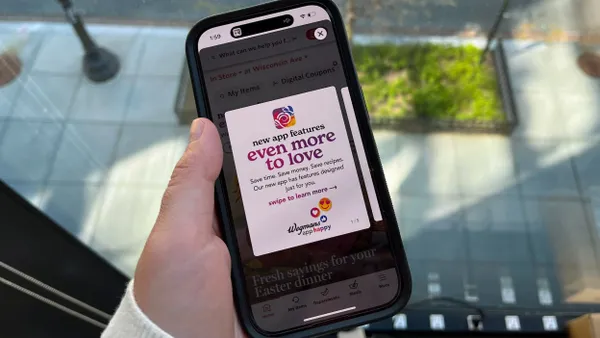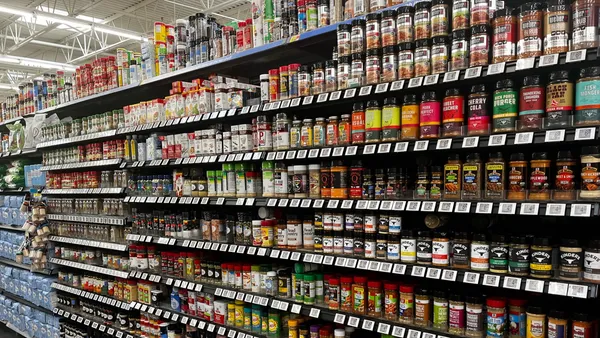In an effort to reduce customer wait times for its Fast Lane curbside pickup, SpartanNash recently began testing a state-of-the-art geofencing system. The program tracks shoppers' locations using the company app, providing updates to store staff so that an employee can deliver each order right as the shopper pulls up.
The system, which SpartanNash initiated in partnership with Radius Networks, has cut wait times from an average of eight minutes to practically zero, said Matt Van Gilder, the company's director of e-commerce, during a presentation at last month's Digital Food & Beverage Conference.
There's just one wrinkle: Walmart and Target already offer the same technology at hundreds of stores.
Fine-tuning e-commerce platforms can feel like a constant game of catch-up for regional grocers, many of whom rushed online in the months following Amazon's 2017 acquisition of Whole Foods. With fewer resources and technical prowess than the major chains, they lack the ability to be first in their markets to offer eye-catching innovations that can win shoppers over.
This could prove costly in the long-run. Despite all the sales growth projected to flow online in the coming years, analysts predict the spoils will not be distributed evenly. A report issued last year by Deutsche Bank analysts predicts large players with the ability to invest in services and navigate complex operations will gain market share over smaller competitors. The report estimated Amazon will increase its e-grocery market share to 19% by 2025 while Walmart will claim 17% and Kroger 7%.
But SpartanNash, which owns several regional grocery brands including Family Fare and Martin's Super Markets, isn’t ready to concede too much ground to the likes of Walmart. Personal service and fostering a sense of trust are two areas where smaller grocery chains can win, Van Gilder said — a belief underscored by the fact that many shoppers still don't trust someone else to buy their perishables for them.
SpartanNash drills its Fast Lane personal shoppers for days on everything from customer service basics to avocado selection. Promotional materials refer to them as "the pickiest shoppers in the store." To make sure employees are motivated to deliver high-quality service, stores run quarterly and annual contests to see who can accrue the most positive customer comments. The winner of the yearly contest gets $500 and two paid days off.
"They know they're not going to get the comments if they're not checking the dates, going through all those meat and produce items carefully and getting customers the best service they can," Van Gilder told Grocery Dive in an interview. "That really drives them to push the program and maintain the good word-of-mouth."
The added motivation is helping, as SpartanNash sees a higher distribution rate for produce online than in stores, Van Gilder said.
At the same time, the retailer-distributor wants to keep up with the latest services and tech innovations. It recently rolled out a $49-per-year pickup subscription service that's gaining traction with shoppers. It's also updating its systems to provide customers with real-time updates on product stock levels. Allowing customers to make their own substitutions instead of getting a call or email from the company after the fact telling them a product is out-of-stock just isn't good service, Van Gilder said.
SpartanNash wants to increase its Fast Lane subscriptions since those customers spend 30% more on average with the company than before signing up. Fast Lane also attracts new customers, particularly in rural markets where SpartanNash's stores are the main operators in their communities. Van Gilder noted 40% of the program's sales come from shoppers who haven't shopped the company's stores in at least 12 weeks.
But getting shoppers to add another subscription to their lives means SpartanNash needs to add extras to sweeten the deal. The company can't offer streaming video like Amazon Prime, Van Gilder said, but it has experimented with offering an additional 10% off private label products.
"They can go to a Walmart and get free curbside pickup," he said. "They don’t have to pay for a subscription. So how do we stay competitive there?"
Personal service and a dash of innovation
Like SpartanNash, Lowes Foods promotes its personal shoppers as a trusted resource for customers. In an interview with Grocery Dive, senior e-commerce director Chad Petersen said these employees are a "differentiator" for the company. The East Coast chain, which operates close to 100 stores, also recently began offering a wide selection of prepared foods online, leveraging a key category for the grocer.
Lowes Foods To Go, the company's e-commerce platform, actually started more than 20 years ago as an order-by-phone service. Lowes has kept phone orders going for the elderly customers who prefer it, said Petersen, but these days the company is focused primarily on its click-and-collect service and on building out home delivery through providers Instacart and Shipt.
"It sounds corny but so much of it comes down to trust," Petersen told Grocery Dive. "It’s getting that first order and second order and third and really building that trust over time."
During a separate panel at the Digital Food & Beverage Conference, Petersen said e-commerce has operated as a separate division within Lowes for the past three years. He said it's been difficult to "get over the hump" and build out a team and the necessary systems, but the company is now in a position to drive sales and own more of the customer experience online.
"We’re lucky we've been doing it so long, we have the staging rooms and curbside areas and all those things," Petersen said during the panel. "But there is an investment."
Similarly, Giant Food Stores underwent a major shift internally as it built out its e-commerce business, digital and e-commerce director Robert Welsh said during a presentation.
"We had lots of training, lots of presentations to our internal stakeholders to bring them along on this journey because it's lots of change," he said. "Any time you’re encountering lots of change, you need as much communication as possible."
The company, along with other retail brands operating under parent company Ahold Delhaize, has a unique asset in Peapod, the storied e-grocer. Earlier this year, Giant launched a new e-commerce brand, Giant Direct, Powered by Peapod. The brand includes store pickup and delivery as well as dedicated e-commerce hubs, the first of which opened in Lancaster, Pennsylvania in February.
To support online fulfillment in Lancaster, Giant Foods opened a state-of-the-art dark store optimized for order picking. It features algorithm-based product selection software that distributes order fulfillment across four picking zones, allowing workers to pick up to 10 different orders at a time.
"This facility was built for complete efficiency," said Welsh. "We were still rebuilding some of the trust with that market based on some store closings we had, so it was big news in that market."
In addition to new branding and technology, Giant Food has focused on marketing its new Direct services. Welsh said that although many of its customers know Giant Food stores, they're unfamiliar with online offerings and how to use them.
"Aggressive acquisition marketing is really the lifeblood," he said during his presentation. "You have to be aggressive to the point that you're uncomfortable. It's one of the hardest things I've encountered with the e-commerce business."
Major retailers are also aggressively marketing their online services. The splashiest example of this is Walmart's television ad campaign for its grocery pickup service, including a spot during the Golden Globes in January that featured famous movie cars pulling up to collect their orders.
That spot, which got more than 6 million YouTube views in less than 24 hours, earned considerable buzz for Walmart. But Petersen and Van Gilder both noted that the ad had the effect of boosting interest across the industry.
"They're taking curbside pickup and making it more mainstream," Van Gilder said. "They’re doing a lot of the legwork to make the whole industry more attractive for the customers."





















